Main menu
Common skin conditions

NEWS
Join DermNet PRO
Read more
Quick links
Skin signs of neurological diseases — extra information
Skin signs of neurological diseases
Author: Dr Sara de Menezes, Basic Physician Trainee, Alfred Health, Melbourne, Australia. DermNet Editor in Chief: Hon A/Prof Amanda Oakley, Dermatologist, Hamilton, New Zealand. December 2016.
Introduction
Neurocutaneous disorders
Neuropsychiatric and addiction disorders
Disorders related to drug abuse
Neuropathic itch
Introduction
Neurological diseases associated with skin signs include:
- Neurocutaneous disorders
- Neuropsychiatric disorders and addictions
- Disorders related to drug abuse.
Neuropathic itch is also discussed in this topic.
Neurocutaneous disorders
Neurocutaneous disorders are a group of congenital multisystem diseases that result in the growth of tumours in the brain, spinal cord, skin and other organs.
Tuberous sclerosis complex
Tuberous sclerosis complex (TSC) is an autosomal dominant syndrome caused by mutations in the tumour suppressor genes, TSC1 and TSC2. Diagnosis of TSC is based on major and minor clinical criteria. Major features have higher specificity for TSC than minor features. Note that there is no single diagnostic feature, and none are specific for TSC.
Skin manifestations of tuberous sclerosis include:
- Major features:
- Facial angiofibromas or forehead plaque
- Non-traumatic ungual or periungual fibromas
- Three or more hypomelanotic macules
- Shagreen patch (a connective tissue naevus).
- Minor features:
- Multiple and randomly distributed dental enamel pits
- Gingival fibromas
- Confetti skin lesions.
Other clinical manifestations include retinal nodular hamartomas, and lesions in the kidneys (angiomyolipomas), heart (rhabdomyomas) and brain (subependymal giant cell astrocytomas, cortical tubers). Patients often have learning and behavioural difficulties and seizures.
Cutaneous signs of tuberous sclerosis
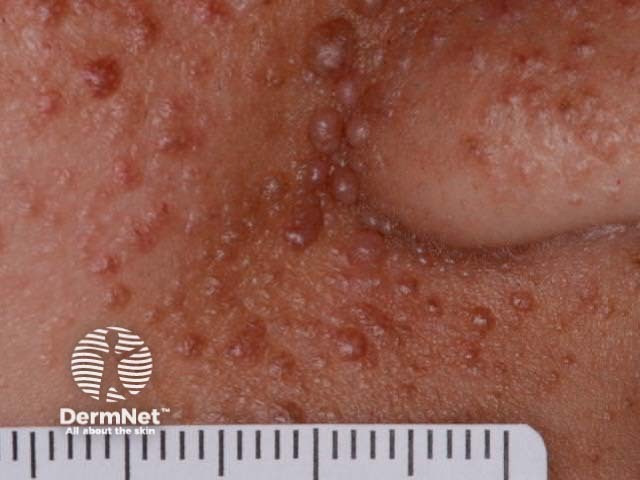
Angiofibromas
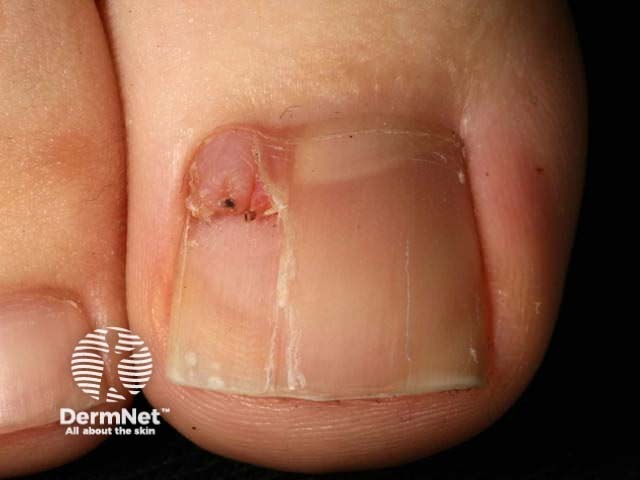
Ungual fibroma
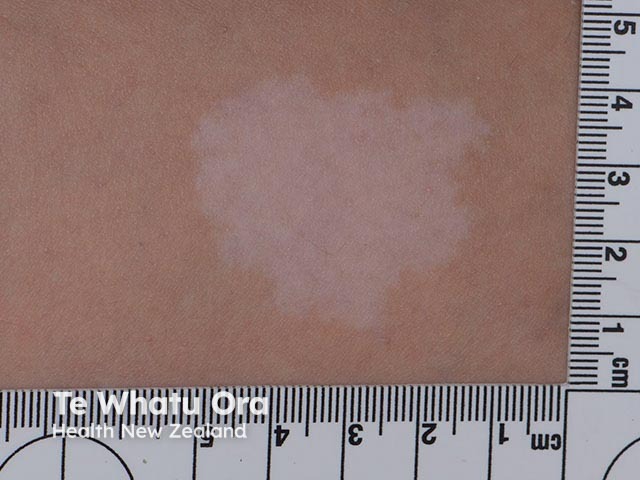
Ash leaf macule
Neurofibromatosis
Neurofibromatosis is an autosomal dominant condition with three distinct clinical subtypes:
- Neurofibromatosis type 1 (von Recklinghausen disease; NF1)
- Neurofibromatosis type 2 (NF2)
- Schwannomatosis.
Similar to tuberous sclerosis, patients with neurofibromatosis can have learning difficulties.
Cutaneous features of NF1 include:
- Café-au-lait macules (flat, brown marks)
- Neurofibromas of any type, including plexiform neurofibroma
- Axillary or inguinal freckling
- Lisch nodules (brown spots on the iris).
Cutaneous features of NF2 include:
- Café-au-lait macules
- Cutaneous schwannoma or neurilemmoma (purplish plaques)
- Cutaneous neurofibromas (uncommon; indistinguishable from NF1).
Non-cutaneous features of NF1 and NF2 include:
- Bilateral vestibular schwannomas (seen on CT or MRI imaging)
- Meningiomas, ependyomas/gliomas of the central nervous system
- Schwannomas of the spinal cord, cranial and peripheral nerves
- Hearing loss
- Paralysis.
Features of schwannomatosis include:
- Multiple painful schwannomas in peripheral and paraspinal nerve roots
- Vestibular schwannomas do not occur (unlike in NF2)
- A normal lifespan.
Cutaneous signs of neurofibromatosis
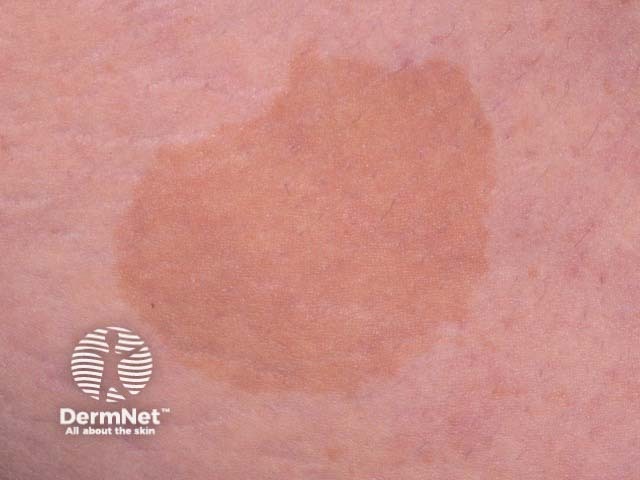
Café au lait macule
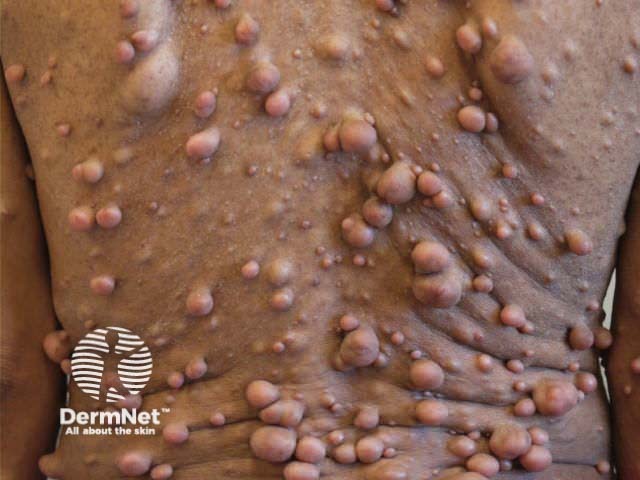
Neurofibromas
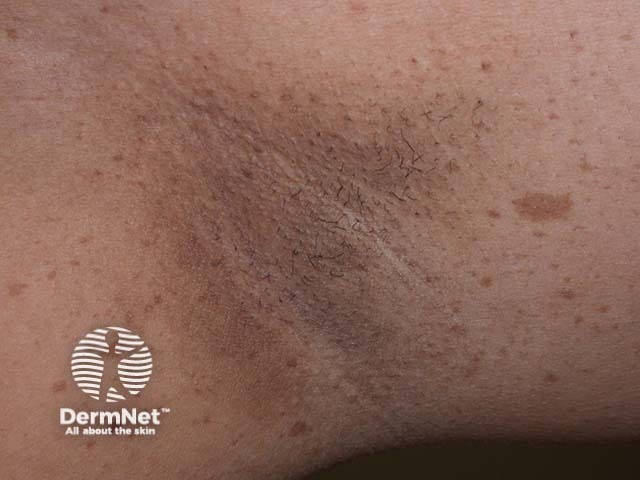
Axillary freckling
Ataxia-telangiectasia
Also known as Louis-Bar syndrome, ataxia-telangiectasia is a rare autosomal recessive disorder that affects the central and peripheral nervous systems. Ataxia (unsteady gait) is often the earliest clinical manifestation of this condition.
Cutaneous telangiectasias (spidery blood vessels) develop after the age of 3 years. They begin in the corners of the eye (ocular canthus) and spread to the membrane covering the eye (bulbar conjunctiva). Telangiectasias may later develop on the cheeks, ears, eyelids, chest, and skin folds of knees and elbows.
Other cutaneous features of ataxia-telangiectasia include:
- Dry skin
- Grey hair
- Scleroderma (atrophy and sclerosis) of the face, arms and hands
- Recurrent impetigo
- Seborrhoeic dermatitis and blepharitis
- Non-infectious cutaneous granulomas
- Basal cell carcinomas.
Non-cutaneous features of ataxia-telangiectasia include:
- Recurrent bacterial or viral sinus and lung infections
- Immune deficiencies with reduced IgA, IgE and IgG
- Dysarthria (unclear speech) over time
- Deterioration in fine and gross motor skills, with patients, often relying on wheelchairs to mobilise.
Sturge–Weber syndrome
Sturge–Weber syndrome is a rare disorder that involves vascular malformations affecting the face and eye, which correspond with a leptomeningeal angioma, a vascular tumour in the brain. This often causes corresponding neurological and ocular deficits.
Neurological features are progressive and can include seizures, focal neurological deficits and intellectual disability. Visual field defects are also common if the occipital cortex of the brain is involved.
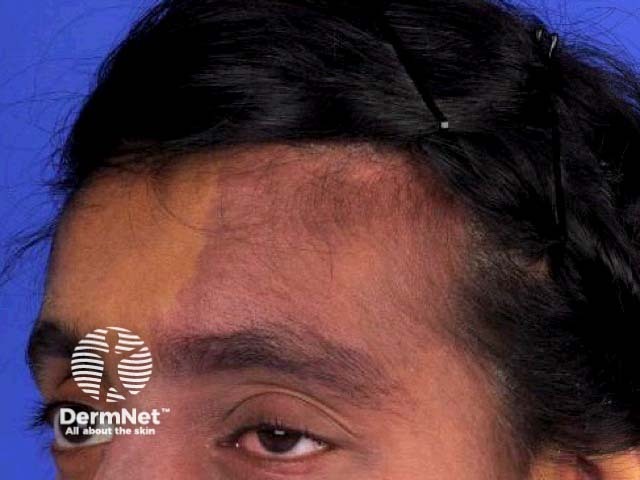
Sturge-Weber syndrome
Neuropsychiatric and addiction disorders
Psychiatric disorders are central nervous system conditions with a neurobiological basis. They generally involve disturbances of emotion, cognition, motivation and socialisation. Psychiatric disorders can either lead to psychocutaneous (skin) manifestations as a consequence or they may arise as a result of a chronic dermatological condition that impacts on the patient’s mental health.
Psychocutaneous disorders
There are four main types of primary psychocutaneous diseases.
Delusional disorder
A delusional disorder may present as delusions of parasitosis.
- In such cases, there is a fixed, false belief by the patient that they are infested with parasites. This may be the only overt manifestation of psychosis.
- Patients present with ‘matchbox sign’ – that is, they present ‘evidence’ of parasites to the clinician in the form of skin crusts, clothing lint or debris (collected in a matchbox or another small container).
- Excoriations and ulcers are the results of the patient’s attempts to eradicate the ‘parasites’.
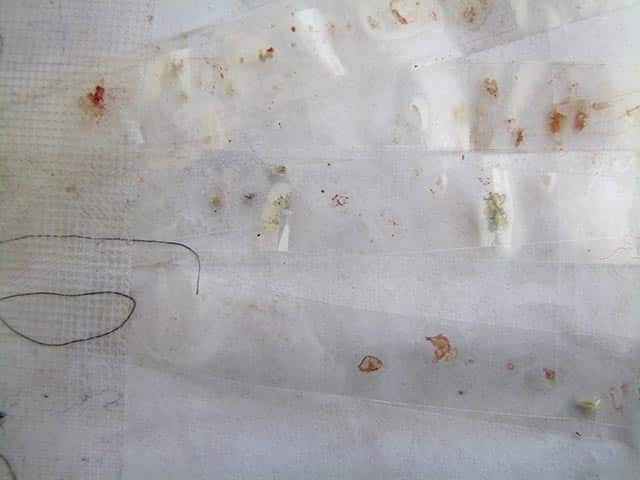
Delusions of parasitosis
Factitious disorder
A factitious disorder may present as dermatitis artefacta.
- In these cases, there is intentional skin injury to allow the patient to fall into the ‘sick role’ and assume illness behaviour.
- Lesions can be in any site but are usually in areas readily accessed by the patient.
- The lesions may have sharp/defined borders and cannot be diagnosed as a known skin disease. They are surrounded by completely normal skin.
- Patients fail to provide a clear history of the evolution of the lesions.
- Dermatitis para-artefacta may be a conscious or semi-conscious manipulation of skin, mainly stemming from impulse control problems (eg, trichotillomania is the repetitive pulling of hair).
Dermatitis artefacta
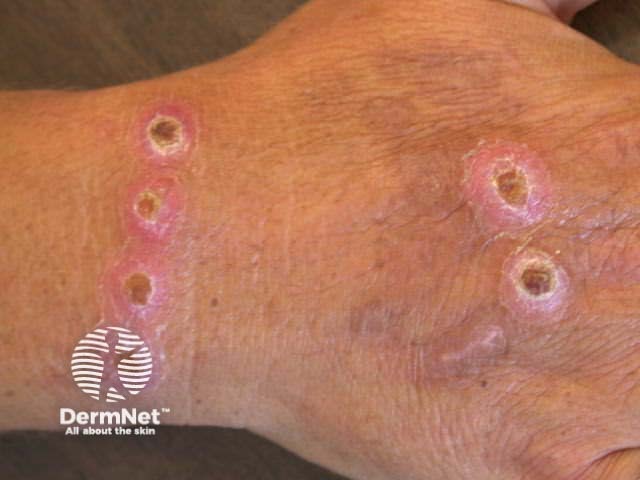
Cigarette burns
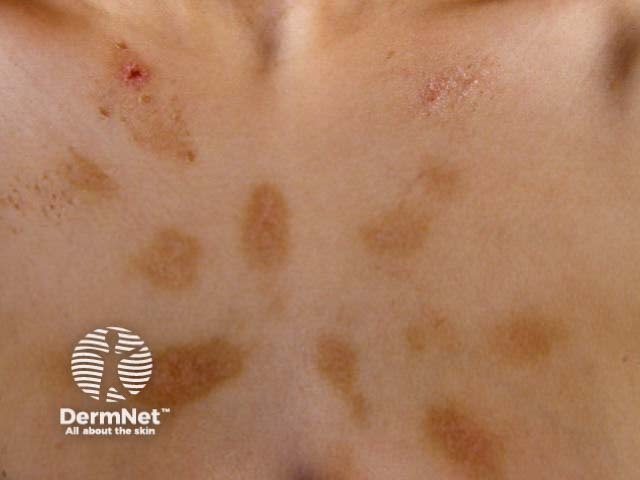
Chemical burns
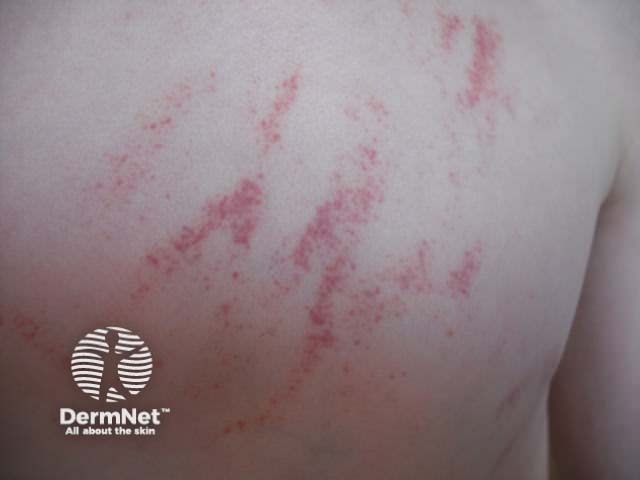
Petechiae due to coining injury
Somatic symptom disorder
Somatic symptom disorder (previously known as a somatoform disorder) may present as cutaneous dysaesthesia.
- Cutaneous dysaesthesia is also known as atypical chronic pain syndrome.
- There is burning, pain or dysaesthesia (unpleasant sensation) from being touched.
- No physical cause for the symptoms is identified.
Compulsive disorder
A compulsive disorder may present as obsessive–compulsive disorder (OCD).
- OCD is an anxiety-related condition associated with repetitive or routine-based behaviours that help the patient to relieve anxiety (eg, compulsive handwashing, compulsive skin picking).
- Compulsive washing can lead to dry skin and irritant contact dermatitis.
- Lichen simplex is a thickened area of the skin resulting from chronic rubbing.
- OCD may also be associated with trichotillomania or skin picking.
Cutaneous signs of a compulsive disorder
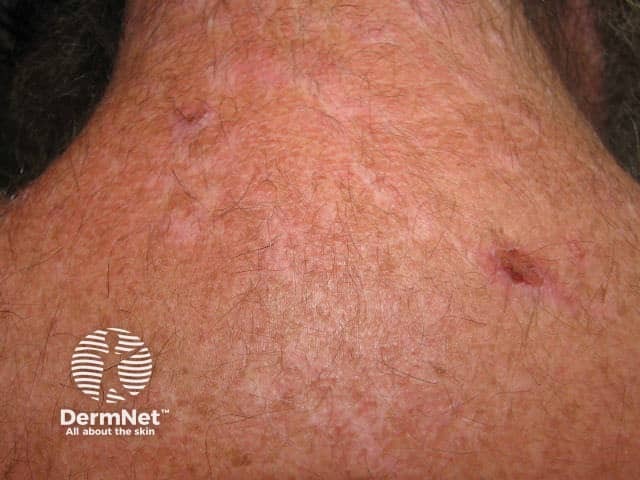
Skin picking
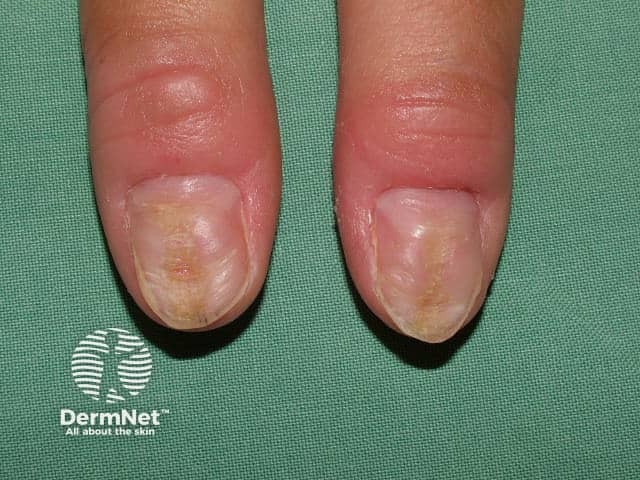
Nail fold picking
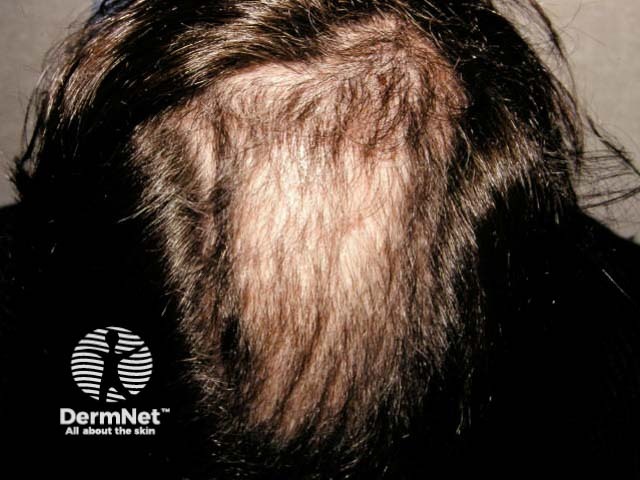
Trichotillomania
Disorders related to drug abuse
The use and abuse of drugs may cause cutaneous manifestations and skin disease as a result of local and systemic toxic effects from the drugs involved.
Chronic alcohol abuse and liver disease
- High circulating bilirubin due to liver disease associated with alcohol abuse presents as jaundice (yellow skin).
- The low albumin associated with chronic alcohol abuse and liver failure can cause Muehrcke lines (leukonychia or white lines on nails) and Terry nails (white nails with red tips).
- Alcohol raises oestrogen levels and high oestrogen may result in gynaecomastia (breast enlargement), palmar erythema and telangiectasia.
- The impairment of coagulation factors through heavy alcohol consumption may cause purpura (easy bruising) and bleeding.
Cutaneous signs of alcohol abuse
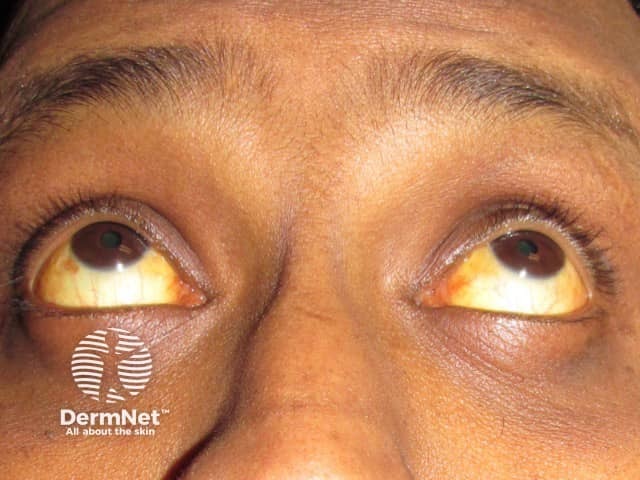
Jaundice
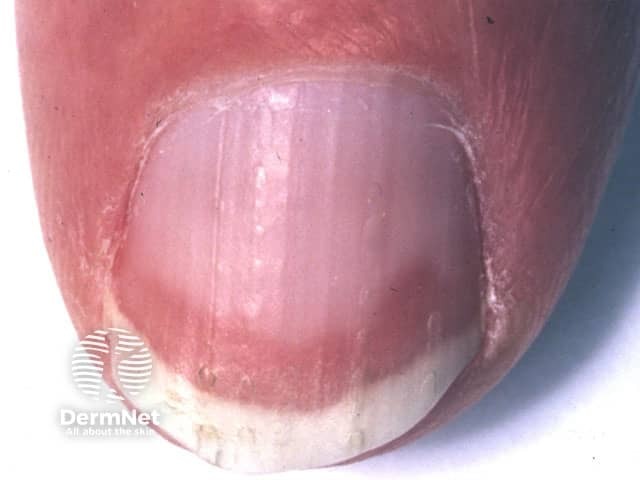
Terry nail
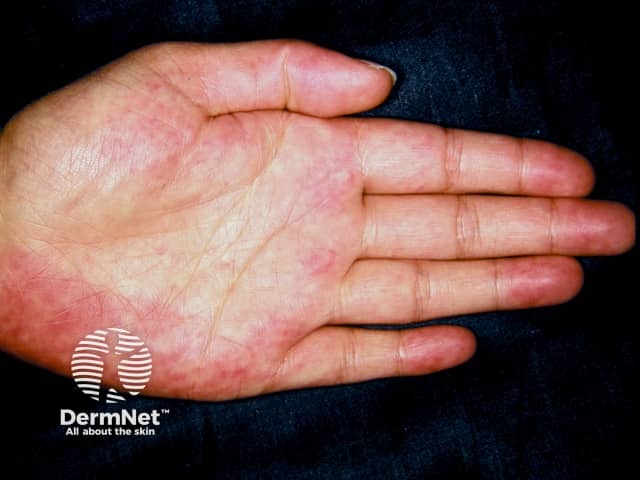
Palmar erythema
Nicotine and cigarette smoking
- The ‘nicotine sign’ is a yellow/orange discolouration of fingertips and nails from cigarette smoking.
- Fingernail clubbing may indicate chronic lung disease as a result of smoking.
- Smokers also present with signs of premature skin ageing, including wrinkles due to the impairment of elastin and collagen function in the skin.
Cutaneous signs of cigarette smoking

Tobacco staining
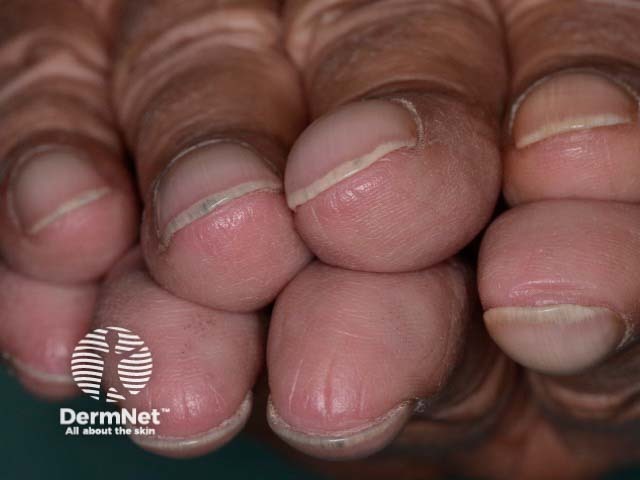
Clubbing
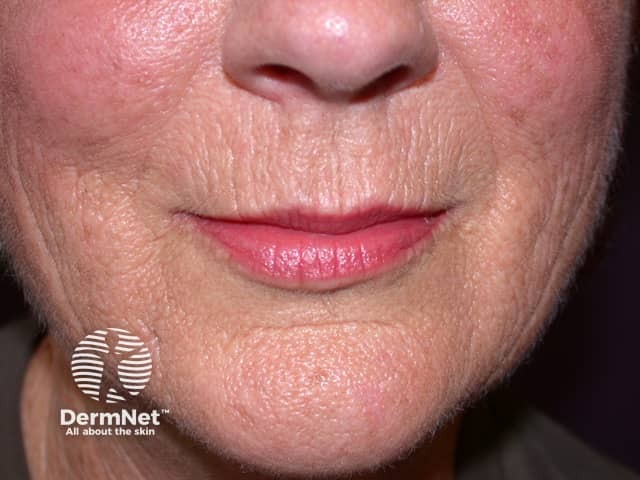
Smoker's lines
Cocaine injected under the skin (‘skin popping’)
- Cocaine use causes skin necrosis, chronic skin ulcers and fibrosis (scarring).
- The skin of cocaine users can also appear atrophic, hypopigmented or hyperpigmented.
Intravenous heroin use
- Heroin users present with ‘track marks’ (linear, cord-like scars following a vascular distribution) from needling.
- Cutaneous nodules, ulcers, panniculitis, skin infections related to intravenous drug use and dermal hardening are all associated with intravenous heroin use.
- ‘Soot tattoo’ — the darkening of the skin from injecting heroin mixed with debris — is also seen in heroin users.
Cutaneous signs of drug abuse
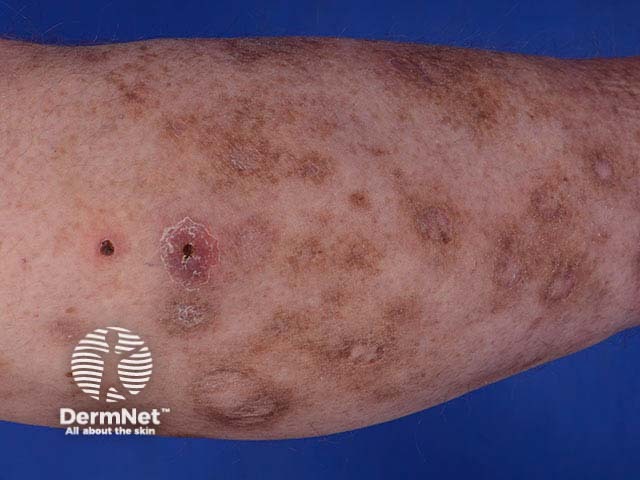
Hyperpigmentation and scarring due to skin infection
Neuropathic itch
Pruritus (itch) can originate from anywhere in the nervous system. Examples of conditions associated with neuropathic itch include:
- Post-herpetic neuralgia — itch or pain that complicates recovery from herpes zoster (shingles)
- Brachioradial pruritus — localised pruritus of the arms as a result of compression of cervical nerve roots (C4–C6)
- Notalgia paraesthetica — localised itch between the shoulder blades as the result of nerve entrapment of the posterior rami of spinal nerves arising at the thoracic vertebrae T2–T6.
- Meralgia paraesthetica – localised itch on the lateral thigh as the result of nerve entrapment of the lateral femoral nerve (L2–L3) under the inguinal ligament.
Neuropathic pruritus
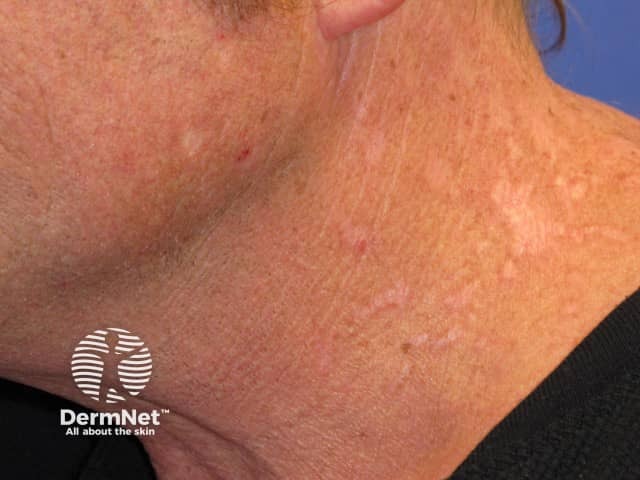
Postherpetic pruritus

Notalgia paraesthetica
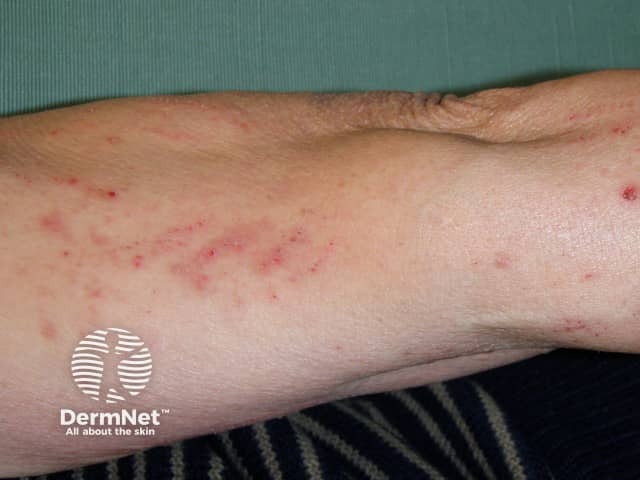
Brachioradial pruritus
References
- Kasper D, Fauci A, Hauser S, Longo D, Jameson J, Loscalzo J (eds). Harrison’s principles of internal medicine. 19th edn. New York: McGraw-Hill, 2015. Available at: http://clinicians.hcn.com.au/ (accessed 20 April 2016).
- Darling TN. Chapter 140. Tuberous sclerosis complex. In: Goldsmith LA, Katz SI, Gilchrest BA, Paller AS, Leffel DJ, Wolff K (eds). Fitzpatrick’s dermatology in general medicine. 8th edn. New York: McGraw-Hill, 2012: 1671–9.
- Listernick R, Charrow J. Chapter 141. The neurofibromatoses. In: Goldsmith LA, Katz SI, Gilchrest BA, Paller AS, Leffel DJ, Wolff K (eds). Fitzpatrick’s dermatology in general medicine. 8th edn. New York: McGraw-Hill, 2012: 1680–90.
- Bodensteiner JB. Sturge–Weber syndrome. In: Post TW (ed). UpToDate. Waltham, MA: UpToDate, 2016. Available at: www.uptodate.com/contents/sturge-weber-syndrome (accessed 28 May 2016).
- Rieder E, Tausk FA. Chapter 104. Psychocutaneous skin disease. In: Goldsmith LA, Katz SI, Gilchrest BA, Paller AS, Leffel DJ, Wolff K (eds). Fitzpatrick’s dermatology in general medicine. 8th edn. New York: McGraw-Hill, 2012: 1158–65.
- Naik H, Johnson RA. Chapter 105. Cutaneous manifestations of drug abuse. In: Goldsmith LA, Katz SI, Gilchrest BA, Paller AS, Leffel DJ, Wolff K (eds). Fitzpatrick’s dermatology in general medicine. 8th edn. New York: McGraw-Hill, 2012: 1166–77.
